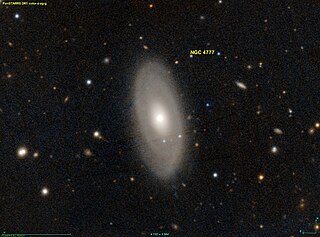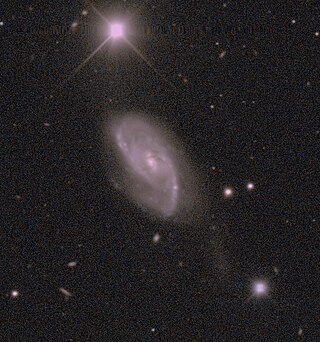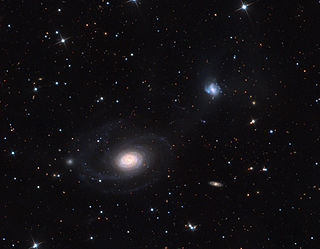
NGC 27 is a spiral galaxy located in the constellation Andromeda. It was discovered on 3 August 1884 by Lewis Swift. It forms a galaxy pair with the nearby UGC 95.
NGC 6566 is a compact elliptical galaxy within the constellation Draco. It is located about 250 million light-years away from the Sun. It was discovered on October 27, 1861 by the astronomer Heinrich d'Arrest.

NGC 4777 is an intermediate spiral ring galaxy. It is estimated to be about 180 million light-years away from the Sun. It was discovered on March 3, 1786 by the astronomer William Herschel.

NGC 321 is an elliptical galaxy located in the constellation Cetus. It was discovered on September 27, 1864, by the astronomer Albert Marth. Measurements of its redshift put it at a distance of about 217.4 ± 15.4 megalight-years (66.67 ± 4.73 Mpc), assuming a Hubble constant of H0 = 67.8 km/sec/Mpc.

NGC 6153 is a planetary nebula in the constellation Scorpius. It was discovered in 1883 by Ralph Copeland.

NGC 62 is a barred spiral galaxy in the constellation Cetus. NGC 62 is its New General Catalogue designation. It has an apparent magnitude of 13.2.

NGC 63 is a spiral galaxy in the constellation Pisces. NGC 63 is its New General Catalogue designation. It has an apparent V-band magnitude of 12.70.

NGC 66 is a barred spiral galaxy discovered by Frank Muller in 1886, and is located in the Cetus constellation.

NGC 112 is a barred spiral galaxy located in the constellation Andromeda. It was discovered by American astronomer Lewis Swift on September 17, 1885. The galaxy lies approximately 295 million light-years from Earth, and is about 75,000 light-years in diameter.

NGC 114 is a barred lenticular galaxy located in the constellation Cetus. It was discovered by American astronomer Truman Henry Safford on September 23, 1867. The galaxy lies approximately 195 million light-years from Earth, and is about 55,000 light-years in diameter, nearly half the size of the Milky Way.

NGC 119 is an unbarred lenticular galaxy with an apparent magnitude of 13.0 located in the constellation Phoenix. It was discovered on October 28, 1834 by the astronomer John Herschel.

NGC 120 is a lenticular galaxy of type SB0? pec? with an apparent magnitude of 13.4 located in the constellation Cetus. It was discovered on 27 September 1880 by Wilhelm Tempel.

NGC 4500 is a barred spiral galaxy in the constellation Ursa Major. The galaxy was discovered on April 17, 1789 by William Herschel. It is a blue compact galaxy.

NGC 471 is a lenticular galaxy located about 168 million light-years away from Earth in the constellation Pisces. It was discovered by the German astronomer Albert Marth on November 3, 1864.

NGC 2460 is an unbarred spiral galaxy in the constellation Camelopardalis. It was discovered by German astronomer Wilhelm Tempel on August 11, 1882.

NGC 970 is an interacting galaxy pair in the constellation Triangulum. It is estimated to be 471 million light-years from the Milky Way and has a diameter of approximately 100,000 ly. The object was discovered on September 14, 1850 by Bindon Blood Stoney.

NGC 823, also known as IC 1782, is an unbarred lenticular galaxy in the constellation Fornax. It is estimated to be 194 million light-years from the Milky Way and has a diameter of approximately 100,000 light years. NGC 823 was discovered on October 14, 1830, by astronomer John Herschel.

NGC 3156 is a lenticular galaxy located in the constellation Sextans. It is located at a distance of about 75 million light-years from Earth and is forming a pair with NGC 3169. It was discovered by astronomer William Herschel on December 13, 1784.

NGC 5966 is an elliptical galaxy in the constellation Boötes. NGC 5966 is its New General Catalogue designation. The galaxy was discovered by William Herschel on March 18, 1787. Based on its redshift, it is located about 220 million light-years away from the Sun.

NGC 5533 is an unbarred spiral galaxy in the constellation Boötes. It was discovered by the astronomer William Herschel on May 1, 1785. It has a regular structure, with one tightly wound spiral; its disk is inclined about 53 degrees towards the line of sight.



















